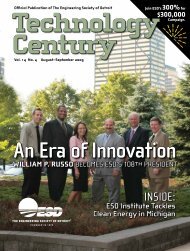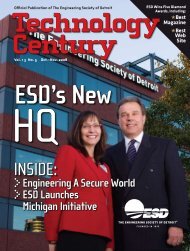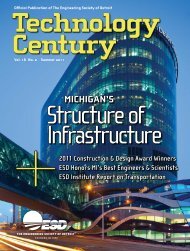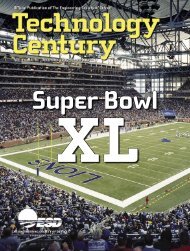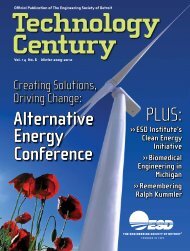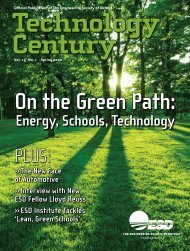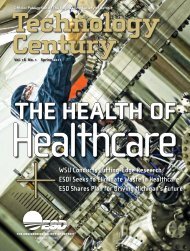Download - ESD
Download - ESD
Download - ESD
- No tags were found...
Create successful ePaper yourself
Turn your PDF publications into a flip-book with our unique Google optimized e-Paper software.
penetrates obstructions. Table 1 lists leading<br />
wireless protocol candidates. 2 Table 2<br />
shows a more technical comparison of the<br />
leading wireless protocol candidates for<br />
in-vehicle use.<br />
IN THE VEHICLE<br />
Current use of wireless networks in vehicles<br />
has been limited to applications such as<br />
remote keyless entry and tire pressure monitoring<br />
systems. Small-scale, true networked<br />
systems have been developed for hands-free<br />
operation of cell phones in automobiles via<br />
Bluetooth. In the future, however, wireless<br />
technology may allow connections between<br />
headrest displays, which could be used for<br />
video sharing.<br />
Engineers are also interested in chassis<br />
and body applications of wireless technology<br />
because of the attractiveness of saving wires,<br />
connectors and their associated weight. Even<br />
powertrain electronics could use wireless<br />
networking to communicate between various<br />
sensors and actuators.<br />
Entertainment<br />
The advantages of wireless networks<br />
are particularly compelling for entertainment<br />
applications because they do not require the<br />
widespread deployment of a wireless infrastructure.<br />
Instead, they obtain and exchange<br />
information with the wireless networks<br />
installed in each consumer’s home. In addition,<br />
entertainment applications offer functionality<br />
that can be used every day, thereby<br />
creating an increased perception of value<br />
by the consumer over other applications<br />
that may only be used occasionally, or even<br />
rarely. In addition, consumers have demonstrated<br />
a willingness to pay for entertainment<br />
features—most recently by the success of the<br />
satellite radio providers. Thus, consumers<br />
can help pay for the hardware by purchasing<br />
entertainment features. This hardware can<br />
then be used to support other applications<br />
that are important, but don’t have a high<br />
perceived value on a day-to-day basis. For<br />
these reasons, we believe that entertainment<br />
applications will be the first vehicle-based<br />
uses of wireless networks.<br />
Fig. 1: Wireless applications for a vehicle are divided into on-board and<br />
o-board categories.<br />
Fig. 2: Major wireless protocols used in the automotive industry compared by range<br />
and throughput.<br />
www.esd.org | The Engineering Society of Detroit | 23





